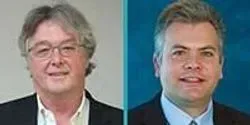Tanuja Koppal, PhD
Articles by Tanuja Koppal, PhD

Zhuoyi Huang, PhD, postdoctoral associate in the laboratory of Dr. Fuli Yu, at the Human Genome Sequencing Center, Baylor College of Medicine, talks to contributing editor Tanuja Koppal, PhD, about the work they have been doing to address the computational challenges associated with analysis of high throughput next-generation sequencing (NGS) data.

Serge Cremers, Pharm. D., PhD, is an associate professor at Columbia University Medical Center and an attending clinical chemist at New York Presbyterian Hospital. He is the director of the Clinical Pharmacology and Toxicology Laboratory at Columbia University Medical Center and the director of the Biomarkers Core Laboratory of the Irving Institute for Clinical and Translational Research, which is home to Columbia University’s Clinical and Translational Science Award (CTSA) and the largest mass spectrometry facility at Columbia University, focusing on targeted metabolomics and the measurement of drugs. Dr Cremers’ areas of expertise are bio-analytical chemistry, translational and clinical pharmacology, therapeutic drug monitoring, as well as clinical chemistry of metabolic bone diseases. He conducts research in all of these areas and has published over 90 papers.

Dieter C. Gruenert, PhD, (bottom left) is a professor of otolaryngology—head and neck surgery at the University of California, San Francisco (UCSF) and pediatrics at the University of Vermont (UVM). He has a PhD in biophysics from the University of California at Berkeley and was a postdoctoral fellow in carcinogenesis at L’Institut Suisse de Recherche Expérimentale sur le Cancer in Lausanne. He was co- director of the Gene Therapy Core Center at UCSF, director of the Division of Human Molecular Genetics at UVM, and head of the Stem Cell Research Program at California Pacific Medical Center. His research focuses on development of gene editing and cell-based therapies for inherited diseases and cancer. He has developed novel diagnostic and oligonucleotide-based therapeutic strategies to ameliorate disease pathology.

Dr. Donald Sakaguchi, professor of genetics, development and cell biology at Iowa State University, talks to contributing editor Dr. Tanuja Koppal about the time and cost savings generated in his lab due to a recent investment in a high-content screening (HCS) system. While his research group can now set up more experiments to look at different cell types and conditions, they also spend more time carefully designing the experiments and optimizing the conditions and later analyzing the vast amounts of data generated from each experiment.

Dr. Nathaniel Hentz is assistant director of the analytical lab at the Golden LEAF Biomanufacturing Training and Education Center (BTEC), where he develops bioanalytical assays in support of the various biomanufacturing processes taught at BTEC. Since 2008, Dr. Hentz has been responsible for developing and teaching undergraduate and graduate courses, industry short courses, and government (FDA and BARDA) training courses, with a focus on assay development and validation, quality control, and liquid-handling performance.

Dr. Anne Carpenter leads the Imaging Platform at the Broad Institute of Harvard and MIT—a team of biologists and computer scientists who develop image analysis and data mining methods and software that are freely available to the public through the open-source CellProfiler project.
Dr. Arvind Rao has been an assistant professor in the Department of Bioinformatics and Computational Biology at the University of Texas MD Anderson Cancer Center since 2011.

Linda Wegley Kelly, PhD, a marine microbial ecologist in the Department of Biology at San Diego State University, talks to contributing editor Tanuja Koppal, PhD, about what has changed in the field since 2001, when she started working in the lab. While genomic and sequencing technologies have become easier and cheaper, the work on the bioinformatics side has now become more tedious in terms of the volume of data that needs to be analyzed. While systems for sample collection and storage have become convenient and customizable, the use of automation in microbiology remains fairly limited. Contamination still remains a cause for concern, and protocols have to be rigorously outlined and implemented.

Forest Rohwer, PhD, is a professor in the Department of Biology at San Diego State University. He is a fellow of the American Academy for Advancement of Science (AAAS), American Academy of Microbiology
(AAM), and Canadian Institute for Advanced Research (CIFAR). He led the development of viromics,” which involves isolating and sequencing the RNA/DNA from all the viruses in a sample. From this data, it is possible to determine what types of viruses are present and what functions they are encoding. Dr. Rohwer uses viromics to study ecosystems ranging from coral reefs to the human body and has shown that most genomic diversity on the planet is viral. Dr. Rohwer has published more than 150 peer-reviewed articles, was awarded the International Society of Microbial Ecology Young Investigators Award in 2008, and is listed as one of the World’s Most Influential Scientific Minds (Thomson Reuters 2014).

Reginald Beer, PhD, medical diagnostics initiative leader at Lawrence Livermore National Laboratory, talks to contributing editor Tanuja Koppal, PhD, about the trends and innovations in digital PCR. While touting the advantages of digital PCR, he explains that not every lab needs to invest in this technology. Lab managers should look closely at their samples and assays to determine if digital PCR is needed for their application.

Derek Wachtel, scientist in the DMPK department at Ironwood Pharmaceuticals, and Mingliang Bao, PhD, senior scientist at Labstat International ULC, talk to contributing editor Tanuja Koppal, PhD, regarding various issues they face with sample prep in their laboratories. They both stress that sample prep is very important and a necessary step in any analysis and with newer technologies making it easier and faster to accomplish, there should be no reason to ignore or overlook it.

Geoffrey Bartholomeusz, PhD, associate professor in the Department of Experimental Therapeutics and director of the siRNA Core Facility at the University of Texas MD Anderson Cancer Center, talks to contributing editor Tanuja Koppal, PhD, about why there is a growing interest in replacing some 2D cell culture applications with 3D cell cultures. He talks about where and why he uses 3D-based cell cultures in his lab and what lab managers should take into consideration before making the investment in this innovative technology.













